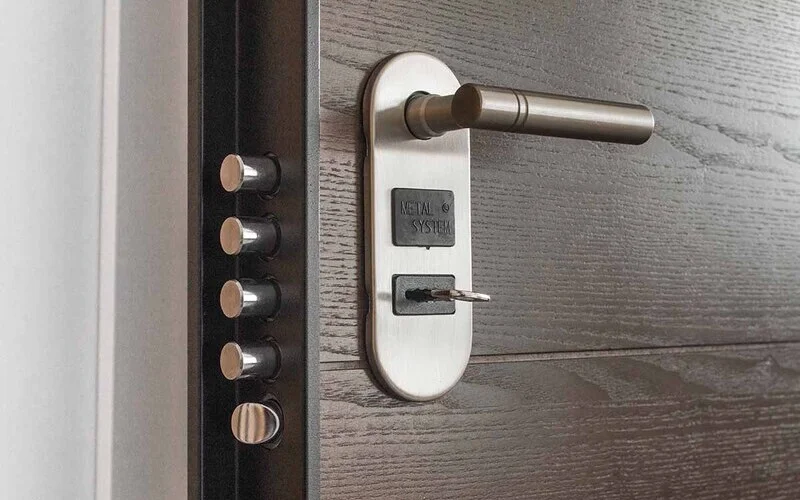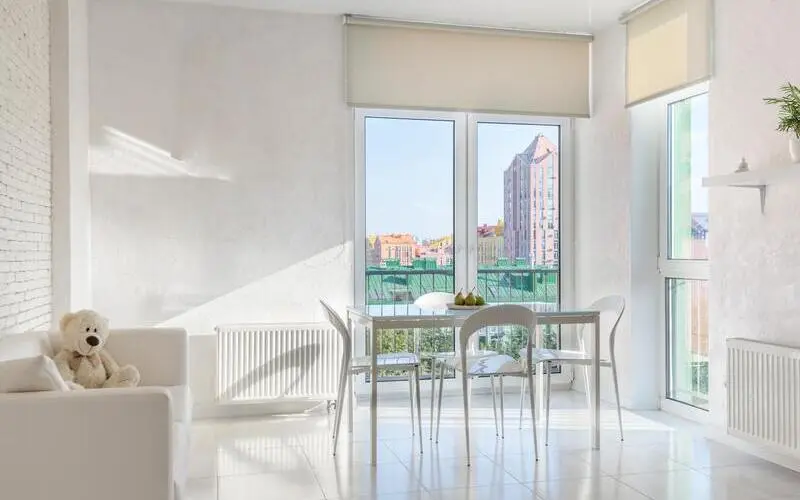Last Updated on November 11, 2023
Having the right external door is crucial for both the aesthetics and security of your home. It serves as the gateway to your personal sanctuary, welcoming guests while keeping unwanted visitors out. Making an informed decision when choosing an external door is of utmost importance to ensure that it not only complements your home’s style but also provides the desired level of protection.
Understanding Types of External Doors
Traditional Hinged Doors
- Characteristics and benefits: Traditional hinged doors offer a classic and timeless appeal. They swing open on hinges, providing a wide entryway that is convenient for moving larger objects.
- Material options and considerations: These doors are available in various materials such as wood, fiberglass, and steel. Each material has its unique characteristics, requiring different maintenance and care routines.
- Style variations: Traditional hinged doors come in an array of designs, from rustic wooden doors to sleek modern ones with glass panels. It allows you to choose a style that suits your home’s architecture and personal taste.
- Popular choices and their features: Some popular choices include solid wood doors for their durability and elegance, fiberglass doors for their resistance to extreme weather conditions, and steel doors for their robustness and enhanced security features.
Sliding Doors
- Advantages and disadvantages: Sliding doors are an excellent option for those looking to optimize space and create a seamless transition between indoor and outdoor areas. They allow for wider views and plenty of natural light to flow in. However, their large glass panels may require more cleaning and maintenance compared to hinged doors.
- Materials suitable for sliding doors: Common materials for sliding doors include aluminum, vinyl, and fiberglass. These materials offer strength and durability while ensuring easy operation and longevity.
- Different types of sliding doors: There are various types of sliding doors available, such as bypass doors, pocket doors, and multi-slide doors. Each type caters to specific architectural needs and space requirements.
- Factors to consider when choosing sliding doors: It is essential to consider factors like weather resistance, energy efficiency, and ease of use when selecting sliding doors for your home.
French Doors
- History and elegance: French doors originated in the 17th century and have since been synonymous with elegance and sophistication. Their characteristic divided glass panels exude a sense of classic charm.
- Materials suitable for French doors: French doors can be crafted from materials like wood, fiberglass, or steel. Each material contributes to the overall durability and aesthetic appeal of these doors.
- Maintenance and care: Proper maintenance and care are essential for French doors, especially when it comes to preserving the integrity of the glass panels and ensuring smooth operation of the hinges.
- Incorporating French doors in different architectural styles: French doors seamlessly blend with various architectural styles, including colonial, Victorian, and Mediterranean. They can be customized to match the overall look and feel of your home.
Materials and Their Advantages
Wood
- Durability, aesthetics, and versatility: Wood offers a timeless beauty that can enhance the overall aesthetics of your home. It is a versatile material that can be crafted into various designs and styles.
- Different types of wood and their characteristics: Options like mahogany, oak, and walnut each have their unique characteristics, such as grain patterns and levels of durability.
- Maintenance tips for wooden doors: To maintain the longevity of wooden doors, regular cleaning, sealing, and refinishing are necessary. It is also important to conduct yearly inspections to spot any signs of damage or wear.
- Considerations when purchasing wood doors: Budget, climate, and maintenance requirements should be taken into account when choosing a wooden door.
Fiberglass
- Strength and resistance to extreme weather conditions: Fiberglass doors exhibit excellent resistance against harsh weather elements such as moisture, heat, and cold. They are less prone to warping or expanding, ensuring long-lasting performance.
- Benefits of fiberglass doors: Apart from being weather-resistant, fiberglass doors are energy-efficient, require minimal maintenance, and can emulate the look of real wood without the associated drawbacks.
- Customization options and styles: Fiberglass doors are available in an extensive range of styles, finishes, and colors to match any architectural design. They can also be customized with decorative glass inserts or sidelights.
- Longevity and maintenance: Fiberglass doors are known for their durability, with some models featuring warranties of up to 25 years. Their low-maintenance nature makes them an ideal choice for busy homeowners.
Steel
- Robustness and security features: Steel doors are renowned for their strength and ability to withstand forceful impacts, making them an excellent choice for enhanced security. They provide peace of mind and act as a deterrent against potential intruders.
- Insulation properties and energy efficiency: Steel doors offer excellent insulation, reducing heat transfer, and improving energy efficiency. This can lead to substantial energy savings over time.
- Design options and finishes: Steel doors are available in a variety of designs, ranging from sleek modern styles to ornate and traditional patterns. They can be further customized with different finishes, including paint, stains, or powder coatings.
- Proper care and maintenance guidelines: Periodic cleaning, routine inspections for rust or dents, and timely touch-ups ensure the longevity and appeal of steel doors.
Glass
- Beauty and natural light integration: Glass doors can transform the ambiance of a space by allowing an influx of natural light. They create a seamless connection between indoor and outdoor areas, blurring the boundaries.
- Types of glass used in external doors: Safety glass, decorative glass, and low-E glass are commonly used in external doors. Each type offers different benefits in terms of security, privacy, and energy efficiency.
- Privacy considerations and solutions: Various techniques like frosted or textured glass, blinds, or curtains can be employed to enhance privacy while still enjoying the benefits of glass doors.
- Security-enhancing features: Reinforced glass, laminated glass, and security film can be installed to improve the security level of glass doors. These features make it more challenging for intruders to gain unauthorized access.
Factors to Consider When Choosing External Doors
- Climate and weather conditions: The climate in your area should influence the choice of materials and door design. Doors need to be able to withstand extreme temperatures, moisture, and other weather elements prevalent in your region.
- Security features: Evaluate the security features of potential external doors, considering factors such as door locks, handles, hinges, and the overall construction of the door.
- Energy efficiency: Look for doors with good insulation properties to prevent heat loss during colder months and reduce energy bills.
- Architectural style compatibility: Ensure that the chosen door design complements the architectural style of your home, contributing to its overall aesthetic appeal.
- Budget considerations: Set a budget and explore options that meet both your financial constraints and quality requirements.
- Maintenance requirements: Take into account the level of maintenance needed for each door material. Consider your available time and resources for maintenance before making a decision.
Measuring and Installation
- Accurate measurements for a perfect fit: Precise measurements are essential for ensuring a seamless fit during installation. Take into account the width, height, and depth of the door frame, as well as the clearances required for its proper operation.
- Professional installation vs. DIY options: While DIY installation may save you money, professional installation guarantees proper alignment, adjustment, and secure attachment of the door.
- Preparing your entryway for installation: Ensure that the entryway is clean, level, and structurally sound before installation. Repair any damages or address underlying issues beforehand.
- Tips for a successful door installation: Follow the manufacturer’s instructions carefully, use appropriate tools, and seek assistance when necessary. Take the time to make necessary adjustments for a proper fit, ensuring smooth operation.
Maintenance and Care
- General maintenance guidelines: Regular cleaning of the door surface, hardware lubrication, and inspection of seals and weatherstripping are important for maintaining the door’s functionality and aesthetic appeal.
- Cleaning techniques for different door materials: Use appropriate cleaning methods for specific materials, such as wood cleaners or mild soapy water for fiberglass doors. Avoid abrasive cleaners that may damage the door’s finish.
- Seasonal maintenance routines: Perform seasonal inspections, paying attention to wear and tear, weatherstripping condition, and any signs of damage or deterioration. Address any issues promptly to prevent further damage.
- Identifying and addressing common issues: Familiarize yourself with common door problems, such as sticking doors, drafts, or squeaky hinges. Learn how to troubleshoot and resolve these issues to maintain the door’s functionality.
Enhancing Security
- Door locks, handles, and hardware options: Choose high-quality door locks, handles, and hardware that provide reliable security features. Opt for options such as deadbolt locks, sturdy door handles, and reinforced strike plates.
- Reinforcing door frames and hinges: Strengthen door frames and hinges by using longer screws, reinforcing plates, or security pins to prevent forced entry.
- Security systems integration: Consider integrating your external door with a home security system, which can provide an additional layer of protection.
- Additional measures for improved external door security: Install security cameras, motion sensor lighting, or door alarms to further deter potential intruders and provide peace of mind.
Aesthetics and Customization
- Choosing the right door style for your home’s architecture: Consider the architectural style and visual theme of your home when selecting a door style. This ensures a harmonious overall appearance.
- Finish options and their impact on curb appeal: Select the appropriate finish, such as paint, stain, or natural wood, to enhance the door’s curb appeal and tie it in with the overall design aesthetic.
- Customization possibilities (glass panels, sidelights, transoms): Incorporate decorative glass panels, sidelights, or transoms to add a touch of personalization and uniqueness to your external door.
- Finding the perfect hardware and accessories for your external door: Choose hardware and accessories that complement the door’s style and finish, creating a cohesive and visually appealing entrance.
Budget-friendly Options
- Cost-effective materials without compromising quality: Explore options like vinyl doors, which provide durability at a reasonable price point. Research affordable brands that offer reliable products within your budget range.
- Buying second-hand or refurbished doors: Consider purchasing pre-owned doors from reputable sources, ensuring they meet quality standards and are appropriate for your home.
- Repurposing existing materials: Repurpose salvaged materials like antique doors or window frames to create unique and sustainable external doors. With a little creativity, you can transform old materials into focal points of your home’s exterior.
- DIY projects for giving your external door a new look: Consider refinishing, repainting, or adding decorative elements to an existing door to give it a fresh and updated look. This cost-effective option can breathe new life into your external door.
Summary
Choosing the right external door requires thoughtful consideration of various factors, including material options, security features, energy efficiency, and architectural compatibility. Understanding the different types of doors available, their advantages, and maintenance requirements is vital. Accurate measurements and professional installation help ensure a perfect fit. Regular maintenance and care are essential for preserving the door’s functionality and appearance. Enhancing security and aesthetics can be achieved through proper hardware selection and customization options. Budget-friendly alternatives, such as cost-effective materials or DIY projects, offer practical choices for homeowners. By considering all these aspects, you can make an informed decision and find the ultimate external door for your home.



